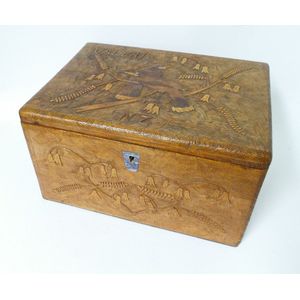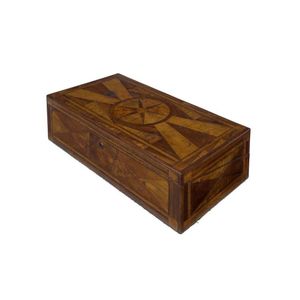Tasmanian Inlaid Timber Deed Box, 1850
You must be a subscriber, and be logged in to view price and dealer details.
Subscribe Now to view actual auction price for this item
When you subscribe, you have the option of setting the currency in which to display prices to $Au, $US, $NZ or Stg.
- Ebony - Ebony is a close grained timber, black in colour. It has a fine texture which can be polished to a high gloss, making it suitable for venereering, inlay and stringing and its use as solid timber is resticted to small decorative items and ornamental decoration, such as chess pieces and musical instrument parts. The term "ebonised" means "faux ebony", timber that has been darkened during the polishing process to resemble ebony.
- Attributed - A cataloguing term where the item in the opinion of the cataloguers, is a of the period of the artist, craftsman or designer, and which probably in whole or part is the work of that person.
- Blackwood - One of the best known and most widely used Australian timbers, blackwood (acacia melanoxylon), is a member of the Acacia (wattle) family and grows in eastern Australia from about Adelaide in South Australia, as far north as Cairns in Queensland.
The largest, straightest and tallest trees come from the wet forest and swamps of north-west Tasmania where it is grown commercially.
Blackwood timber colours range across a wide spectrum, from a very pale honey colour through to a dark chocolate with streaks of red tinge.
The hardwood timber has been commonly used in the production of furniture, flooring, and musical instruments in Australia from the late 19th century. However, the straight grain timber is not the most prized or valuable, that honour falls to blackwood with a wavy, fiddleback pattern, which is used both in the solid and as a veneer. Fiddleback was only used on the finest examples of furniture. - Musk Wood - The musk is native to Tasmania, and is found in the rainforests and wetter regions especially along river banks. It grows to a height of between five and fifteen metres, it has a musk scent. A rare timber and therefore mainly used as a veneer in the 19th-century, it is light brown in colour and furniture constructed from it is very expensive.
- Circa - A Latin term meaning 'about', often used in the antique trade to give an approximate date for the piece, usually considered to be five years on either side of the circa year. Thus, circa 1900 means the piece was made about 1900, probably between 1895 and 1905. The expression is sometimes abbreviated to c.1900.
This item has been included into following indexes:
- boxes, function - deeds and document boxes 103
- boxes, material or decoration
- Dowling, Richard (Australia) - wooden boxes 4
Visually similar items

A New Zealand timber folk art jewellery box, carved in low relief to the lid and walls with huia birds and kowhai, named 'Valerie' to the lid, the interior with blue velvet lining and removable tray. 30 cm x 22 cm x 17 cm

A New Zealand timber box, most likely the work of W.H. Jewell, late 19th century, 7 cm high, 18 cm wide, 18 cm deep

A Victorian walnut writing box inlaid with brass and mother of pearl, with original inkwells, interior restored. 14 cm high, 35 cm wide, 24 cm deep

A superb Tasmanian timber writing box, huon pine, musk, cedar, blackwood, myrtle, beefwood, honeysuckle and casuarina, cedar secondary timbers, fitted with slope and drawer compartments, circa 1850, 18 cm high, 61 cm wide, 31 cm deep
